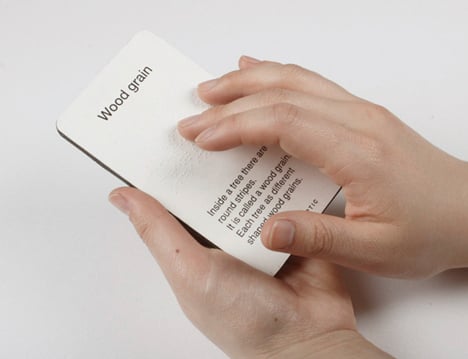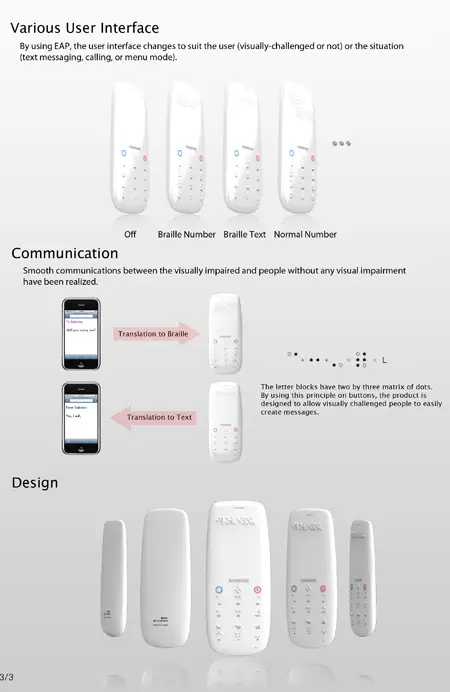Tactile Flash Cards for the Blind via Yanko Design
The haptic flashcards were designed by people from the Samsung Design Membership, and were awarded the 2009 Silver International Design Excellence Award:
Designers:
Rhea / Young Soo -- Hongik University
Sunmin -- Ewha Women’s University
Sae Hee--Hanyang University
"The Hello Haptic set of flash cards works with Braille text and other tactile elements from environments the student might not otherwise have access to."

Saturday, August 29, 2009
Hello Haptic flash cards
Samsung Braille TouchPhone Prototype is Cool: Uses Electric Active Plastic for Functional Tactile Feedback
From the Tuvie blog: Braille Concept Phone for Visually Challenged People
"Braille phone is a universal cellular phone concept that is able to produce Braille code in a particular part of it by using Electric Active Plastic to make it usable for visually handicapped people. The phone has been designed in a simple and easy to use manner and looks like a television remote control. The Braille area provides all the information that a traditional screen of a cell phone displays so that visually impaired people can read them by touching it. It provides letter blocks in two by three dot matrixes and by using this principle on buttons, visually challenged people can easily create or read text messages. This braille phone just won Red Dot Awards 2009."


Information from the Samsung website:
SAMSUNG's Braile Mobile Phone Wins Gold Award at the IDEA 2006 Awards (7/2006)
Earlier version:

RELATED:

SPICEMOBILEPHONES
Touch Sight: Camera for the blind may open a lot of eyes

IEEE Spectrum Electric Flex
Wednesday, August 26, 2009
Microsoft Surface Multi-touch Application for Pediatric Neuropsychology Assessment and Rehab, by VectorForm
Neuro-rehab tools from VectorForm on MS Surface from Health 2.0 on Vimeo.
Pediatric neurological rehabilitation.
"Vectorform LLC, in cooperation with Cook Children's Health Care System, has created a suite of applications to assist with motor control and learning for neurological rehab. These applications are designed to exercise and evaluate a patient's motor control. Each application was designed to allow the clinician to manipulate test conditions and tailor the therapy to address the unique needs of each patient." -Reuters, 4/3/09
According to the Vectorform blog, Cook Children's Medical Center now has five Microsoft Surface units. Table-top applications would be great for psychological assessment, intervention, and special education support for students with a variety disabilities.
Sunday, August 23, 2009
What's New in Assistive Technology and Augmentative Communication? AbilityNet GATE - Global Assistive Technology Encyclopedia Shows it All
The AbilityNet GATE wiki is the place to go for new and updated information about assistive technology. The site is a wiki, created by AbilityNet, of the UK. The motto on the home page is uplifting:
"Knowledge is power, but it is distributed information which is truly empowering."
Here is the video from AbilityNet GATE that provides a short overview of assistive technology:
(The music on the video is Jimmy Eats World "Big Casino")
The AbilityNet GATE wiki has a wealth of information, video clips, and photos, plus an RSS feed aggregator that highlights the latest in assistive technology news.
You can also get additional information about assistive technology from AbilityNet's related sites: AbilityNet E-learning
AbilityNet Website
AbilityNet YouTube
AbilityNet MySpace
AbilityNet Wiki
AbilityNet Twitter
Other sources of information (on AbilityNet wiki)
Friday, August 14, 2009
Multi-touch Tables for Education: Link to post
The following link is to a blog post about teacher Tom Barett's experience with networked tables, including a video. The post also outlines Tom's recent experiences as one of the first teachers to have a SMARTTable in his classroom.
Tom Barrett Demonstrates Durham University's SynergyNet Mutli-touch Networked Tables
Brainport Vision Device enables people who are blind see in 3D via tongue.
The best part of this video is when the man is able to play a games (tic-tac-toe & rock, paper, scissors) with is daughter as he uses the vision device:
(The father depicted in the video is Erik Weihenmayer, who is a professional mountaineer and motivational speaker. He's the only blind person to have climbed the "Seven Summits", the highest points on each continent.)
Photo courtesy of engadget
The system uses a head-mounted video camera which takes in visual information and translates it into electric patterns on a tab placed on the tongue in such a was that 3D representation is interpreted by the brain.
It should be noted that the BrainPort vision device is investigative and not yet available for sale.
RELATED
BrainPort Vision
Lollipop Helps Reveal Shapes To the Blind
Ibby Caputo, Washington Post, 7/21/09
Publications
(Also posted on the Interactive Multimedia Technology blog.)
Wednesday, August 05, 2009
Great Video Short: Thinking Outside the Box (and inside out, around, and in many other ways)
Watch how the ideas unfold and spiral about as two gentlemen have a conversation about thinking thoughts:
outside the box from joseph Pelling on Vimeo.
Thanks, Matt Gullet, for sharing this video!
Tuesday, August 04, 2009
Low Tech: Historical psychological assessment collection from Brazil- via Kevin McGrew
Kevin McGrew, a psychologist and blogger, recently spent some time in Brazil attending a conference, and while he was there, he came across a collection of historical psychological assessment kits used in Brazil.
Below is just one picture of many assessment tools:
-picture taken from Kevin McGrew's blog
Kevin McGrew is known for his work in psychological & educational measurement (Woodcock-Johnson), learning, applied psychometrics, and related areas. His blog, "Intelligent Insights on Intelligence Theory and Tests (AKA IQ's Corner) holds a wealth of information and links. You can follow Kevin on Twitter, subscribe to his blog, and access his presentation slides on SlideShare.




